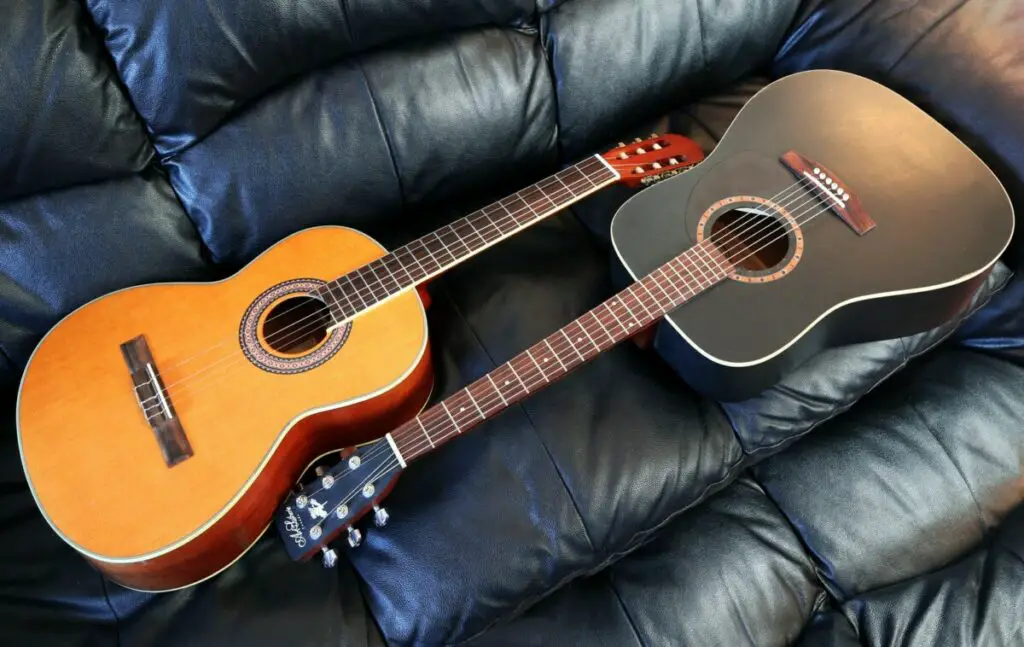
If you own an acoustic guitar, it’s important to take proper care of it in order to ensure it lasts as long as possible. One way to care for your guitar is to humidify it properly.
Humidifying your guitar helps prevent damage to the instrument and ensures it sounds great for years to come. Below, we’ll explore a few different ways you can humidify your acoustic guitar. I’ll even reveal the guitar humidifier I personally use for my own acoustic guitar.
But before we get into all that, let’s explore whether you really need to humidify your guitar in the first place:
Why Humidify an Acoustic Guitar?
As you know, a guitar is largely made out of wood. With acoustic guitar, the tonewoods or woods that make up the body of the guitar are rather thin in order to allow the sound to reverberate within the body of the guitar. These pieces of wood actually expand and contract slightly according to humidity levels.
If a guitar is not humidified, it can lead to shrinkage or warping of the wood, and result in problems like:
- sharp frets (from fretboard shrinkage)
- wood splits in the top / face of the guitar
- tone changes as a result of wood warping / shrinkage
To avoid all this, it’s best to invest in a simple humidifier in order to preserve the tone and quality of your instrument over the long term.
How to Humidify an Acoustic Guitar
There are a few different ways to humidify a guitar. The most popular option is to humidify your guitar inside of its gig bag or case. This is often done with a soundhole humidifier, which, as the name suggests, goes inside the soundhole of the guitar and humidifies it from within.
This is how I personally humidify my Martin D18.
There are a lot of different in-case guitar humidifiers or soundhole humidifiers. I personally use a Dampit, and I’m very happy with it:
The reason I think the Dampit is the best in-case / soundhole humidifier for guitars is because you only have to purchase it once. A lot of the other cheap guitar humidifiers out there require you to buy “hydration packs” to stock/replace the humidifier with. Buying these things over and over again can really add up. With the Dampit, on the other hand, you simply buy it once, and it will last you for years.
The Dampit is perfect for me because I only have one acoustic that I really need to humidify, but what happens if you own many acoustic guitars? Constantly changing out soundhole humidifiers in multiple guitars can certainly become a hassle if you own lots of instruments.
No need to worry, though, because that’s where room humidifiers come in:
The Best Room Humidifier for Guitars
A room humidifier helps adjust the humidity in the room to a certain level. This allows you to just leave your guitars sitting out.
The key, however, is to get a room humidifier that allows you to adjust the humidity percentage. This is very important because you want your guitar in a room at 45-55F% humidity.
I personally like the LEVOIT humidifier (on Amazon) because it allows you to adjust the humidity accordingly:
The other nice thing about the LEVOIT is that it has near-silent noise levels, so it’s never a nuisance.
Simply dial in a 45-55F% setting on your room humidifier, add water, and you should be good to go.
How Long Should You Humidify a Guitar?
Finally, I want to wrap up by answering another common question, which is how long to humidify a guitar for.
If you live in a dry climate, it’s best to always have your guitar humidified. If you miss a day or two, it’s not a huge deal, especially if you keep your guitar in its case. But it’s best practice to have an acoustic guitar consistently humidified at around a 50% humidity level.
If you own an expensive guitar, such as a Martin or Taylor guitar, it’s best to simply keep the guitar properly humidified, almost as a form of insurance. This will ensure that you don’t have to deal with splits in the tonewood, which can be costly to fix and even alter the tone of your instrument.
Ready to Get Better at Guitar, Faster?
Whenever you’re ready to take your guitar playing to the next level, check out a few of my favorite resources below:
The Best Acoustic Guitar Strings – A unique polymer coating makes these guitar strings last for months or even years at a time, making for an exceptional value. They provide the perfect mix of boom, range, twang, and brightness that acoustic music is known for. — CLICK HERE TO LEARN MORE
The Best Acoustic Guitar – Beloved by everyone from Paul Simon to Gordon Lightfoot, the Martin D-18 is one of Martin’s most legendary guitars ever… It’s an excellent, premier quality acoustic guitar for bluegrass, country, folk, rock and more. This is also what I play myself — CLICK HERE TO LEARN MORE
Chords, Tabs & Video Lessons for 100 Epic Songs – This free guide that I created for fellow guitarists gives you chords, tabs, and video lessons for the 100 best songs to learn on guitar… I spent many hours putting this guide together to help you get better at guitar, faster. — CLICK HERE TO GET IT FREE
Fingerpicking vs Flatpicking Guitar – Learn which picking style is right for YOU by exploring examples, history, and popular players of each style. Discover essential techniques and pros and cons of each approach. — CLICK HERE TO GET IT FREE


